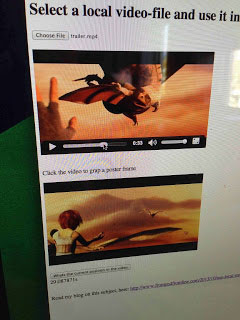
As everybody knows, HTML5 came with the audio and video tags, and their respective cool javascript APIs. Very powerful stuff, but for a recent project I needed to use this on a file completely client side. I came up with a solution that uses an input type=file form upload field as the source for a video-element. I needed to mark in- and outpoint and set a video-frame for the poster, while the file was uploading. (the server would then do some ffmpeg magic to actually slice the video, and add the poster-frame to the database).
My demo is right here - make sure you select a media file thats supported by your browser (webkit->mp4/webm, ff -> ogv, IE10+ -> who knows/cares)… http://cdpn.io/bhCHu
The magic is in this line
videoEle.src = window.URL.createObjectURL(this.files[0]);
where ‘this’ is the -field. (note the shim for prefixing URL.createObjectURL in the top, so it works in webkit/non-webkit-browsers - webkit needs a prefix).
Now you can use all the events and properties of the media-element on a local file. To get the current time of the video being shown the media element has properties like
videoEle.currentTime
and many more. You can do lots of other stuff with the mediaElement - check out this resource: http://www.w3.org/2010/05/video/mediaevents.html
For trapping a frame I use the canvas-element, and the secret is getting the context and using the videoElement (and dimensions) as parameters for the drawImage()-method.
var canvasContext = posterCanvas.getContext('2d');
canvasContext.drawImage(videoEle, 0, 0, videoEle.offsetWidth, videoEle.offsetHeight);
For uploading the canvas to your server you could use posterCanvas.toDataURL(‘image/jpeg’) and send that string to the server that can make it into a file. (I’m aware that ffmpeg can also output a single frame from a video and a timecode, but for the sake of the demo, I thought I would do that client-side also).
